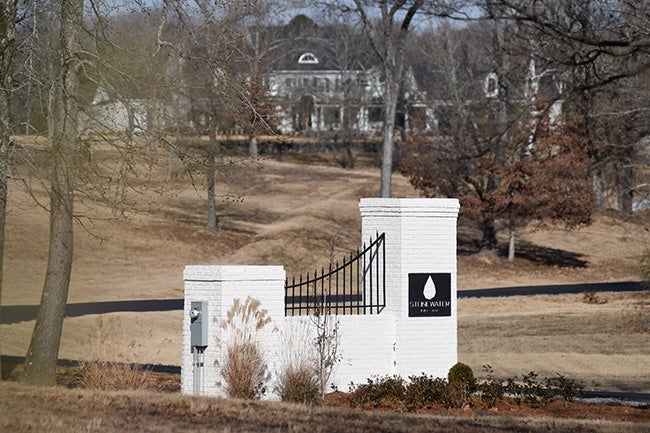Stonewater Recovery Center’s proposed expansion concerns planning commission and neighboring Lafayette County residents
Published 6:38 am Sunday, December 17, 2017

- The Stonewater Adolescent Recovery Center, in Oxford, Miss., located on County Road 362.
A local adolescent recovery center has become a sore subject for some on the Lafayette County Planning Commission, who recently rejected a proposed expansion after concerns about safety and proximity to other county residents.
Located on 65 acres in the Clear Creek community, the Stonewater Adolescent Recovery Center has faced adversity since opening its doors in March 2017.
The planning commission rejected Stonewater’s proposal to expand the facility from a main house with a 10-bed dormitory area on the second floor, as well as a separate outpatient structure, to a compound with multiple outpatient structures, an equestrian center and enough dormitories to house 160 patients.
Ray Garrett, an Oxford attorney and member of the planning commission, said the direction the facility is currently heading is different from the original proposal.
“We were told they were going to have a small facility, that they would not have anybody who was going to be out of their immediate control,” Garrett said. “I voted for it originally, because these people need help, and they assured us it was going to be very small and under control.”
Stonewater is, according to CEO Bryan Fikes, a Christian facility designed to provide “pristine, premier adolescent treatment” to young men from across the country.
Previously a residential property, the facility is designed to appear less commercial and more like a home. Young men who come to Stonewater receive one-on-one and group therapy, as well as training in gardening, athletics, fine arts and volunteering as part of their treatment. The facility has a physician and nurses on staff as well to provide medical care for patients.
Stonewater is certified by the Mississippi Department of Mental Health, which isn’t a legal requirement for a facility of that nature, but one Fikes says allows them to follow industry best practices and provide a higher standard of treatment.
Fikes admits the full vision for Stonewater is not something that can happen soon but says the organization plans to accomplish construction in phases.
“The idea is that we will build incrementally, starting with maybe next year, one or two [dormitories],” Fikes said. “I think that’s where some of the confusion rested with the planning commission and maybe even some of the community, is that they’re envisioning this happening overnight or over a year. This is maybe a five- to 10-year goal, that’s what we’re shooting for.”
Garrett says the facility’s administration has failed when it comes to patient supervision and has no plans of maintaining their original status as a small-scale operation.
Another concern is its proximity to residents in the Clear Creek community. With six reported runaways (and subsequent returns) since March 2017, citizens are concerned for both the safety of the patients and their own families.
Charles Lipe, pastor of Clear Creek Baptist Church, says safety is the issue for himself and his congregation regarding the patients and residents of Clear Creek.
“There’s maybe a quarter-acre of land in between the facility and the church, and most of the congregation lives around there,” Lipe said. “I have no problem with the gentlemen who are doing this. We’re on the same team. It’s not what they’re doing; it’s where they’re doing it.”
According to Lipe and members of the planning commission, the idea of a fence or other increased security measures has been presented to Stonewater’s administration but, so far, the level of patient security has not changed.
Other residents have voiced similar concerns, including Lindsay Hollowell, who lives across from the facility.
“I’m sure they’re wonderful kids, but it only takes one erratic moment for something bad to happen,” Hollowell said. “This is our home, and they could have built a few miles out.”
Fikes says he is aware of the opposition, but maintains that the facility and its patients are not a threat to the residents of Clear Creek.
“We’re not trying to admit or treat the guy who’s going to take off running down the street. Now, that stuff happens, but we’re trying to prevent that guy from ever stepping foot on our campus,” he said. “We have a comprehensive 14-page elopement manual with detailed instructions on how to manage those types of situations.”
T.J. Ray, member of the Lafayette County Planning Commission, says based on the last request and subsequent rejection of the facility’s proposal, that another solution needs to be found.
“We had problems with their security to start with, and to bring in a bunch of teenagers that already have troubles, and not have more security than what they have, is not promising,” Ray said. “I don’t understand why the [Lafayette County Sheriff’s Department] deputies have to basically be on call. It seems like they’re using the sheriff’s department as a security system, and that’s not the way it ought to work.”
The outcry from the community has been “clear as a bell,” and taken into account by both the planning commission and board of supervisors.
“For the first time in my two years on the planning commission, a supervisor came and not only observed the meeting but came and spoke against a project,” Garrett said. “It’s very unusual for there to be enough public outcry for a supervisor to come speak.”
Fikes says he is not ready to give up on Stonewater’s plans for expansion just yet.
“I just want people to know that we’re an organization that takes doing things the right way very seriously,” Fikes said. “We want to be one of the premier adolescent recovery centers in the entire country. That is a tremendous opportunity for Oxford and the community as a whole.”





